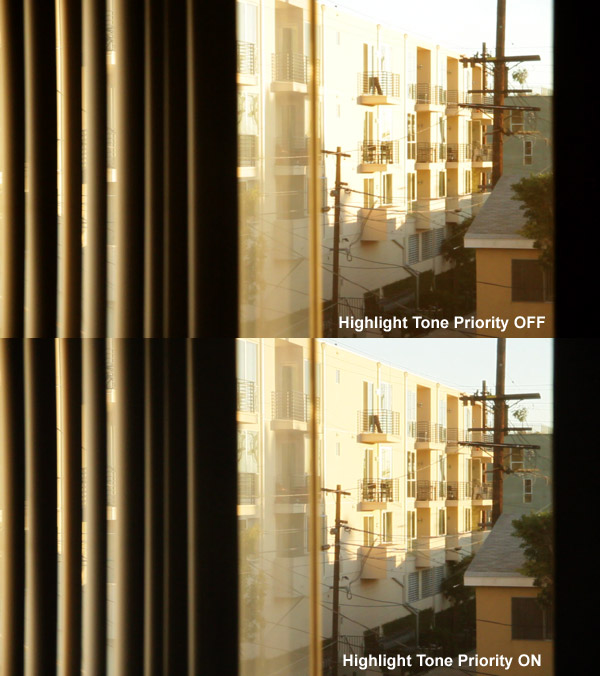Highlight Tone Priority in Canon’s DSLRs
I've noticed that several people have searched this blog for the string "highlight tone priority," and since inquiring minds want to know, I figured I would write a post about it. Highlight Tone Priority is a setting option on Canon's DSLRs that is often misunderstood. Some people swear by it, and others avoid it like the plague. It can be a useful tool in some circumstances, but just like the choice of "native" vs. "non-native" ISO settings, it is important to understand what it does, how it works, and just what the trade-offs are before deciding whether or not to do use it.
The purpose of Highlight Tone Priority is to increase the effective dynamic range of the camera, specifically by giving you extra protection in the highlights, while keeping the overall exposure the same. In other words, if two identical pictures are taken at the same exposure, one with HTP on and one with it off, the picture taken with HTP on will have fewer blown out highlights. Below is an example.
Both of the above images were shot at ISO 1600, at f2.8, with a shutter speed of 1/50th, and with the same amount of ND. The top one was shot with HTP off and the bottom one was shot with HTP on. The difference is immediately apparent. While the darker areas of the image remain very similar (the vertical blinds, the house and tree at the bottom right of the frame, etc), the bottom image clearly has much more highlight detail. Whereas in the top image the whole sky and much of the building are clearly blown out, in the bottom image the building and sky both retain significant detail.
Sounds great, right? After all, blown out highlights is one of those ugly qualities that screams out "video", and its far superior dynamic range is one of the last things keeping film alive at all. So, why wouldn't anyone want to use such a feature? Well, to answer that question you need to know how Highlight Tone Priority works, and as you might have guessed, there's no such thing as a free lunch.
Canon HD DSLR “Native ISO”
If you've spent any time researching Canon's HD DSLR cameras, you've probably come across discussions of which of the cameras' ISO settings to use and which to avoid. There seems to be a common misconception out there, held by even some very well-regarded experts (http://www.zacuto.com/shootout, webisode 2, about 3 minutes in) that the cameras' "native ISO" or "true ISO" settings are the multiples of 160 (ISO 160, ISO, 320, ISO 640, etc), and that the rest of the ISO settings are produced digitally. This is not true. In fact the cameras' native ISO settings (that is, the settings that are derived from analog gain rather than digital exposure compensation) are the multiples of 100 (ISO 100, ISO 200, ISO 400, ISO 800, etc). However, that doesn't necessarily make them better.
I believe that much of the confusion comes from mis-analyzing tests such as these:
http://marvelsfilm.wordpress.com/2009/10/10/canon-7d-noise-and-iso-test/
http://www.cinema5d.com/viewtopic.php?f=14&t=4736
that clearly show that the 160-multiple ISO settings exhibit less noise than the 100-multiple ISO settings. Viewing these test results is often surprising to people because it goes against the conventional wisdom that the higher the ISO, the noisier the image will be, and the lower the ISO, the cleaner it will be. In fact, it is very surprising to learn that ISO 1250 can look on par with or even better than ISO 125. The natural assumption when looking at these tests is that the native ISOs must be the cleanest ones. This seems like a logical assumption at first, but it doesn't hold up when you look at it a little bit closer.
Canon’s 5D Mark II and 7D Depth of Field: Is Less Always More?
HD capable DSLRs seem to be everywhere these days, with projects ranging from low-budget feature films to primetime network television programs taking advantage of the cameras. They offer HD imaging with cinematic 35mm depth of field in a tiny package at a bargain-basement price. What's not to love?
As an HD DSLR owner myself, I will be talking a lot about these cameras on this blog, but in this post I would like to focus (no pun intended) on that cinematic depth of field. After all, this is really what sets these cameras apart from pretty much any other HD camera even remotely in the same price range.
There seems to be a lot of confusion about the term "full frame sensor". I would like to try to clarify this concept, specifically in terms of how it relates to what are no doubt the two most popular HD DSLRs, the Canon 5D Mark II and the Canon 7D.
